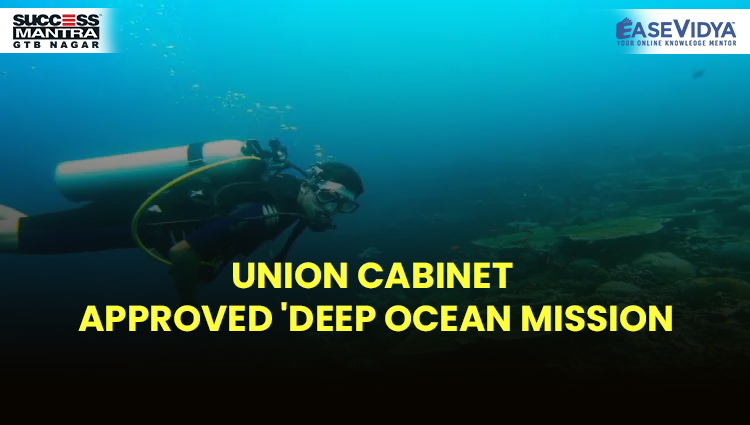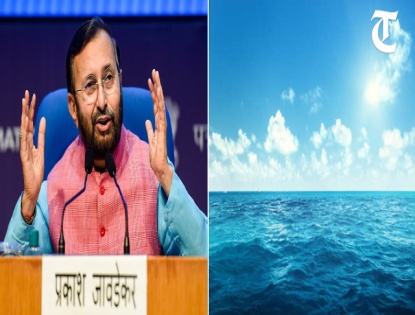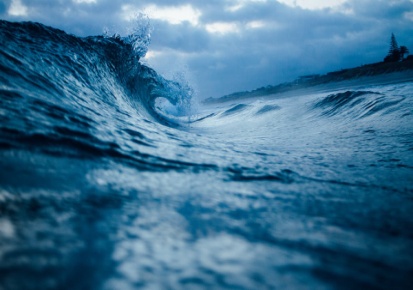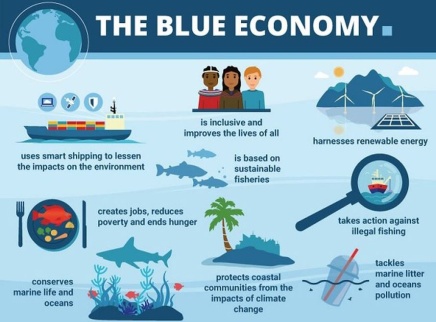
UNION CABINET APPROVED DEEP OCEAN MISSION
UNION CABINET APPROVED 'DEEP OCEAN MISSION'

Recently, the Cabinet Committee on Economic Affairs has approved the proposal of the Ministry of Earth Sciences (MoES) on the Deep Ocean Mission (DOM). The blueprint of the DOM to explore the deep recesses of the ocean was unveiled in 2018. Earlier, MoES had also rolled out the draft Blue Economy Policy.
ABOUT THE MISSION
The cost of the Mission has been estimated at Rs. 4,077 crore over a five-year period and will be implemented in phases. MoES will be the nodal ministry implementing this multi-institutional ambitious mission. It will be a mission mode project to support the Blue Economy Initiatives of the Government of India. Blue Economy is the sustainable use of ocean resources for economic growth, improved livelihoods and jobs, and ocean ecosystem health. The technology and expertise needed in such missions is now available with only five countries - US, Russia, France, Japan and China. India will now be the sixth country to have it.
MAJOR COMPONENTS OF THE INITIATIVE
- Development of Technologies for Deep Sea Mining, and Manned Submersible: A manned submersible will be developed to carry three people to a depth of 6,000 metres in the ocean with a suite of scientific sensors and tools. An Integrated Mining System will be also developed for mining polymetallic nodules at those depths in the central Indian Ocean. Polymetallic nodules are rocks scattered on the seabed containing iron, manganese, nickel and cobalt. The exploration studies of minerals will pave the way for commercial exploitation in the near future, as and when commercial exploitation code is evolved by the International Seabed Authority, an United Nations (UN) organisation.
- Development of Ocean Climate Change Advisory Services: It entails developing a suite of observations and models to understand and provide future projections of important climate variables on seasonal to decadal time scales.
- Technological Innovations for Exploration and Conservation of Deep-sea Biodiversity: Bio-prospecting of deep sea flora and fauna including microbes and studies on sustainable utilization of deep sea bio-resources will be the main focus.
- Deep Ocean Survey and Exploration: It will explore and identify potential sites of multi-metal Hydrothermal Sulphides mineralization along the Indian Ocean mid-oceanic ridges.
- Energy and Freshwater from the Ocean: Studies and detailed engineering design for offshore Ocean Thermal Energy Conversion (OTEC) powered desalination plants are envisaged in this proof of concept proposal. OTEC is a technology which uses ocean temperature differences from the surface to depths lower than 1,000 meters, to extract energy.
- Advanced Marine Station for Ocean Biology: It is aimed at the development of human capacity and enterprise in ocean biology and engineering. It will translate research into industrial application and product development through on-site business incubator facilities.
IMPORTANCE & SIGNIFICANCE

Oceans, which cover 70% of the globe, remain a key part of our life. About 95% of the Deep Ocean remains unexplored. Three sides of India are surrounded by the oceans and around 30% of the country's population living in coastal areas, the ocean is a major economic factor supporting fisheries and aquaculture, tourism, livelihoods and blue trade. India has a unique maritime position. Its 7517 km long coastline is home to nine coastal states and 1382 islands. The Government of India's Vision of New India by 2030 announced in February 2019 highlighted the Blue Economy as one of the ten core dimensions of growth. Oceans are also a storehouse of food, energy, minerals, medicines, modulator of weather and climate and underpin life on Earth. Considering the importance of the oceans on sustainability, the UN has declared the decade, 2021-2030 as the Decade of Ocean Science for Sustainable Development.
OTHER BLUE ECONOMY INITIATIVES
- India-Norway Task Force on Blue Economy for Sustainable Development : It was inaugurated jointly by both the countries in 2020 to develop and follow up joint initiatives between the two countries.
- Sagarmala Project: The Sagarmala project is the strategic initiative for port-led development through the extensive use of IT enabled services for modernization of ports.
- O-SMART: India has an umbrella scheme by the name of O-SMART which aims at regulated use of oceans, marine resources for sustainable development.
- Integrated Coastal Zone Management: It focuses on conservation of coastal and marine resources, and improving livelihood opportunities for coastal communities etc.
- National Fisheries Policy: India has a National Fisheries policy for promoting 'Blue Growth Initiative' which focuses on sustainable utilization of fisheries wealth from marine and other aquatic resources.
DRAFT BLUE ECONOMIC POLICY

Recently, the Ministry of Earth Sciences (MoES) has rolled out the draft Blue Economy policy, inviting suggestions and inputs from various stakeholders. It is in line with the Government of India’s Vision of New India by 2030. The policy document highlighted the blue economy as one of the ten core dimensions for national growth. It emphasizes policies across several key sectors to achieve holistic growth of India’s economy. It recognizes the following seven thematic areas:
- National accounting framework for the blue economy and ocean governance.
- Coastal marine spatial planning and tourism. Marine fisheries, aquaculture, and fish processing.
- Manufacturing, emerging industries, trade, technology, services, and skill development. Logistics, infrastructure and shipping, including trans-shipments.
- Coastal and deep-sea mining and offshore energy.
- Security, strategic dimensions, and international engagement.
Aims: Enhance contribution of the blue economy to India's Gross Domestic Product (GDP). The blue economy, which consists of economic activities dependent on marine resources, comprises 4.1% of India’s economy. Improve lives of coastal communities. Preserve marine biodiversity. Maintain the national security of marine areas and resources.
NEED FOR A BLUE ECONOMY POLICY
Vast Coastline: With a coastline of nearly 7.5 thousand kilometers, India has a unique maritime position. Nine of its 28 states are coastal, and the nation’s geography includes 1,382 islands There are nearly 199 ports, including 12 major ports that handle approximately 1,400 million tons of cargo each year.
Utilisation of Non-living Resources: India’s Exclusive Economic Zone of over 2 million square kilometers has a huge living and non-living resources with significant recoverable resources such as crude oil and natural gas.
Sustenance of Coastal Communities: The coastal economy sustains over 4 million fisherfolk and coastal communities.
WHAT IS BLUE ECONOMY?
The concept was introduced by Gunter Pauli in his 2010 book- “The Blue Economy: 10 years, 100 innovations, 100 million jobs”. It is the sustainable use of ocean resources for economic growth, improved livelihoods and jobs, and ocean ecosystem health. It advocates the greening of ocean development strategies for higher productivity and conservation of ocean's health.
- It encompasses– Renewable Energy: Sustainable marine energy can play a vital role in social and economic development.
- Fisheries: Sustainable fisheries can generate more revenue, more fish and help restore fish stocks.
- Maritime Transport: Over 80% of international goods traded are transported by sea.
- Tourism: Ocean and coastal tourism can bring jobs and economic growth.
- Climate Change: Oceans are an important carbon sink (blue carbon) and help mitigate climate change.
- Waste Management: Better waste management on land can help oceans recover. Blue Economy emphasizes on integration of development of the ocean economy with social inclusion, environmental sustainability, combined with innovative business models.
TEST YOURSELF
Q.1 Recently, the Cabinet Committee on Economic Affairs has approved which of the following Ministries' proposals on the Deep Ocean Mission (DOM)?
- Ministry of Water Resources & River Development
- Ministry of Earth Sciences: ANSWER
- Ministry of Jal Shakti
- None of the following
Q.2 Which of the following given statements is/are correct in the reference to the Deep Ocean Mission of the Central Government?
- The cost of the Mission has been estimated at Rs. 4,077 crore over a five-year period and will be implemented in phases
- It will be a mission mode project to support the Blue Economy Initiatives of the Government of India.
- The technology and expertise needed in such missions is now available with only four countries - US, Germany, France & United Kingdom. India will now be the fifth country to have it.
- II & III follows
- Only I follows
- I, II & III follows
- None of the above: ANSWER
Q.3 Consider the given statements & state which of the following is/are correct in the context of the above mentioned passage?
- The blue economy, which consists of economic activities dependent on marine resources, comprises 4.1% of India’s economy.
- Blue Economy is the sustainable use of ocean resources for economic growth, improved livelihoods and jobs, and ocean ecosystem health.
- Only I follows
- Only II follows
- Both I & II follows: ANSWER
- Neither I nor II follows
Q.4 Considering the importance of the oceans on sustainability, the UN had declared which of the following decades as the Decade of Ocean Science for Sustainable Development?
- Decade of 2021-2030: ANSWER
- Decade of 2031-2040
- Decade of 2041-2050
- None of the following
Q.5 Which of the following is an umbrella scheme of India which aims at regulated use of oceans, marine resources for sustainable development?
- Sagarmala Project
- O-SMART scheme: ANSWER
- STARS Project
- All of the above













0 Comment